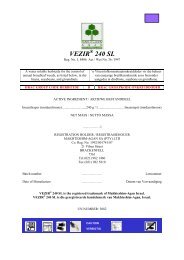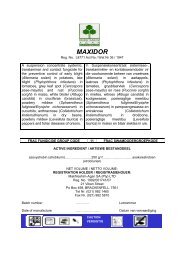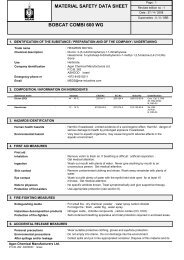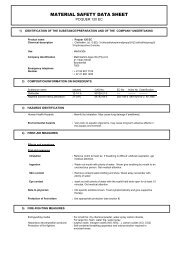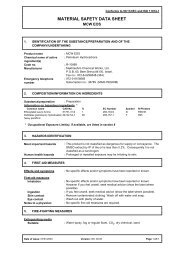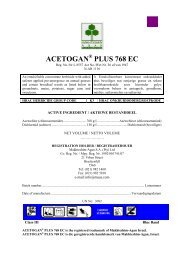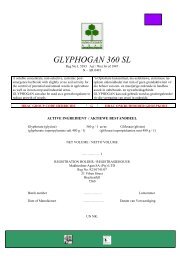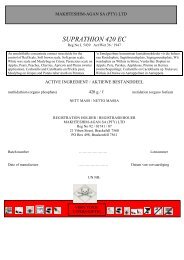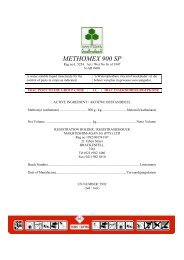SIMANEX 500 SC - Makhteshim-Agan SA (Pty) Ltd
SIMANEX 500 SC - Makhteshim-Agan SA (Pty) Ltd
SIMANEX 500 SC - Makhteshim-Agan SA (Pty) Ltd
Create successful ePaper yourself
Turn your PDF publications into a flip-book with our unique Google optimized e-Paper software.
A suspension concentrate pre-emergence<br />
herbicide for the control of a variety of<br />
annual grasses and broadleaf weeds in apples,<br />
pears, asparagus, triazine resistant canola<br />
cultivars, citrus and vines as well as for<br />
industrial use on uncultivated areas,<br />
roadsides, etc.<br />
<strong>SIMANEX</strong> <strong>500</strong> <strong>SC</strong><br />
Reg no L 5335 Act/Wet 36 / 1947<br />
N-AR 0493<br />
‘n Suspensiekonsentraat, vooropkom<br />
onkruiddoder vir die beheer van ‘n<br />
verskeidenheid eenjarige grasse en<br />
breëblaaronkruide in appels, pere, aspersies,<br />
triasien weerstandbiedende kanola kultivars,<br />
sitrus en wingerde asook vir industriële<br />
gebruik op onverboude terreine, padkante,<br />
ens.<br />
HRAC Herbicide Group Code C 1 HRAC Onkruidodergroepkode<br />
ACTIVE INGREDIENT / AKTIEWE BESTANDDEEL<br />
Simazine (triazine) 490 g / l Simasien (triasien)<br />
Related active triazines 10 g / l Verwante aktiewe triasiene<br />
NET CONTENTS / NETTO INHOUD<br />
…………………<br />
REGISTRATION HOLDER / REGISTRASIEHOUER<br />
<strong>Makhteshim</strong>-<strong>Agan</strong> <strong>SA</strong> (<strong>Pty</strong>) LTD<br />
Reg no 1992/001741/07<br />
21 Viben street, BRACKENFELL<br />
P.O box 498, BRACKENFELL 7561<br />
Tel no: (021) 982 1460<br />
Fax no: (021) 982 5810<br />
Batch number ………………… Lotnommer<br />
Date of Manufacture ..……………… Datum van Vervaardiging
WARNINGS:<br />
• Harmfull if swallowed.<br />
• Store in a cool, dry place away from food, feed, seed and other agricultural remedies.<br />
• Keep out of reach of children, uninformed persons and animals.<br />
• May be irritating to eyes and skin<br />
• May cause sensitization by skin contact<br />
Although this remedy has been extensively tested under a large variety of conditions the<br />
registration holder does not warrant that it will be efficacious under all conditions<br />
because the action and effect thereof may be affected by factors such as abnormal soil,<br />
climatic and storage conditions; quality of dilution water; compatibility with other<br />
substances not indicated on the label and the occurrence of resistance of weeds against<br />
the remedy concerned as well as by the method, time and accuracy of application. The<br />
registration holder furthermore does not accept responsibility for damage to crops,<br />
vegetation, the environment or harm to man or animal or for lack of performance of the<br />
remedy due to failure of the user to follow the label instructions or to the occurrence of<br />
conditions which could not have been foreseen in terms of the registration. Consult the<br />
supplier in the event of any uncertainty.<br />
PRECAUTIONS:<br />
• Avoid inhalation of fumes and spray mist.<br />
• Wash with soap and water after use.<br />
• Wash contaminated clothing after use.<br />
• Do not eat, drink or smoke during mixing or application or before hands and face are<br />
washed.<br />
• No mixing or filling of spray tanks should take place within 15 m of rivers, dams or<br />
boreholes.<br />
• Avoid backward siphoning to boreholes, rivers or dams if the product is applied<br />
through an irrigation system.<br />
• Do not apply the product within 60 m of dams.<br />
• Prevent drift of spray mist onto other crops, rivers, dams or any area that is not under<br />
treatment.<br />
• Clean the applicator thoroughly after application and throw the wash water where it<br />
will not contaminate rivers, dams, boreholes or grazing.<br />
• Avoid the contamination of food, feed, drink water and eating utensils.<br />
• Rinse the empty container three times with a volume of water equal to at least 10 %<br />
of that of the volume of the container. Add the rinsate to the contents of the spray<br />
tank.<br />
• Destroy the empty container and do not re-use for any other purpose.<br />
RESISTANCE WARNING:<br />
For resistance management Simanex <strong>500</strong> <strong>SC</strong> is a group code C 1 herbicide. Any weed<br />
population may contain individuals naturally resistant to Simanex <strong>500</strong> <strong>SC</strong> and other group<br />
code C 1 herbicides. The resistant individuals can eventually dominate the weed population if<br />
these herbicides are used repeatedly. These resistant weeds may not be controlled by<br />
Simanex <strong>500</strong> <strong>SC</strong> or any other group code C 1 herbicides. To delay herbicide resistance:<br />
1) Avoid exclusive repeated use of herbicides from the same herbicide group code.<br />
Alternate or tank mix with products from different herbicide codes<br />
2) Integrate control methods (chemical, cultural and biological) into weed control<br />
programs.<br />
For specific information on resistance management contact your local distributor.
SOME WEED SPECIES NORMALLY CONTROLLED BY <strong>SIMANEX</strong> <strong>500</strong> <strong>SC</strong><br />
Amaranthus hybridus - Cape pigweed<br />
Amaranthus spinosus - Thorny pigweed<br />
Amaranthus thunbergii - Red pigweed<br />
Anagallis arvensis - Scarlet pimpernel<br />
Arctotheca calendula - Cape marigold<br />
Bidens bipinnata - Spanish blackjack<br />
Bidens pilosa - Blackjack<br />
Chenopodium album - White goosefoot<br />
Chenopodium murale - Nettle-leaved goosefoot<br />
Cleome monophylla - Single - leaved cleome<br />
Commelina benghalensis - Wandering Jew<br />
Conyza canadensis - Fleabane<br />
Conyza albida - Tall fleabane<br />
Datura ferox - Large thorn apple<br />
Datura stramonium - Common thorn apple<br />
Erodium moschatum - Musk heron’s bill<br />
Fallopia convolvulus - Climbing knotweed<br />
Fumaria muralis - Fumitory<br />
Galingsoga parviflora - Gallant soldier<br />
Nicandra physaloides - Apple of Peru<br />
Oenothera stricta - Primrose<br />
Polygonum aviculare - Prostrate knotweed<br />
Portulaca oleracea - Purslane<br />
Raphanus raphanistrum - Wild radish<br />
Richardia brasiliensis - Mexican richardia<br />
Schkuhria pinnata - Dwarf marigold<br />
Sisymbrium officinale - Hedge wild mustard<br />
Solanum nigrum - Black nightshade<br />
Sonchus oleraceus - Common sow thistle<br />
Spergula arvensis - Corn spurry<br />
Stellaria media - Chickweed<br />
Tagetes minuta - Tall khaki weed<br />
Urtica urens - Bush stinging nettle<br />
GRASSES<br />
Avena fatua - Common wild oats<br />
Bromus catharticus - Rescue grass<br />
Chloris virgata - Feathertop chloris<br />
Eleusine indica - African goose grass<br />
Eragrotis teff - Teff grass<br />
Lolium perenne - Perennial ryegrass<br />
Lolium temulentum - Darnel<br />
Poa annua - Annual bluegrass<br />
Setaria pallide-fusca - Garden bristle grass<br />
Urochloa panicoides - Garden urochloa<br />
ERRATIC CONTROL MAY BE OBTAINED OF THE FOLLOWING WEEDS:<br />
Emex australis - Spiny emex<br />
Tribulus terrestris - Common dubbeltjie<br />
Digitaria sanguinalis - Finger grass<br />
Oxalis spp. - Sorrel<br />
Setaria verticillata - Bur bristle grass<br />
Plantago lanceolata - Buckhorn plantain<br />
Malva parviflora - Small mallow
This product controls annual grasses and broad leaf weeds. Other annual weeds that were not<br />
present during the development trials with the product, may possibly also be controlled to a<br />
certain degree. The registration holder does however not accept any responsibility for<br />
unlisted weeds.<br />
<strong>SIMANEX</strong> <strong>500</strong> <strong>SC</strong> does not control deep-rooted perennial weeds.<br />
WEED SPECTRUM FOR THE REDUCED RATE IN CANOLA (2,0 l / ha)<br />
Anagallis arvensis - Pimpernel<br />
* Emex australis - Spiny Emex<br />
Erodium moschatum - Musk heron’s bill<br />
Fumaria muralis - Fumitory<br />
Raphanus raphanistrum - Wild radish<br />
* Emex australis control can be erratic<br />
DIRECTIONS FOR USE<br />
USE ONLY AS INDICATED<br />
USE RESTRICTIONS<br />
- DO NOT USE <strong>SIMANEX</strong> <strong>500</strong> <strong>SC</strong> ON STONE FRUIT.<br />
- <strong>SIMANEX</strong> <strong>500</strong> <strong>SC</strong> must not be applied to apples, pears and vines within three years<br />
and citrus within one year after transplant. Prevent treatment of young implants in<br />
established vines and orchards.<br />
- <strong>SIMANEX</strong> <strong>500</strong> <strong>SC</strong> may cause damage to crops which have a trace element deficiency<br />
or which are growing on alkaline or brackish soils.<br />
- <strong>SIMANEX</strong> <strong>500</strong> <strong>SC</strong> must not be applied to newly established Asparagus.<br />
- <strong>SIMANEX</strong> <strong>500</strong> <strong>SC</strong> has a relative long residual action in the soil and susceptible crops<br />
like cereals, vegetable crops and leguminous plants should not be planted within 18<br />
months after application. However, if <strong>SIMANEX</strong> <strong>500</strong> <strong>SC</strong> is applied to triazine resistant<br />
canola in the winter rainfall region at a rate of not more than 2,0 l / ha (1,0 kg a.i / ha)<br />
and normal rainfall occurs, the waiting period on cereals can be reduced to 12 months.<br />
- <strong>SIMANEX</strong> <strong>500</strong> <strong>SC</strong> may ONLY be used on triazine resistant canola cultivars<br />
COMPATIBILITY<br />
The compatibility of <strong>SIMANEX</strong> <strong>500</strong> <strong>SC</strong> with other products can be influenced by the<br />
formulation of those products and the quality of the dilution water. The formulation of<br />
products can change without the knowledge of <strong>Makhteshim</strong>-<strong>Agan</strong> and the water quality can<br />
differ from farm to farm. It is therefore advisable to do a compatibility test before an<br />
application takes place. <strong>SIMANEX</strong> <strong>500</strong> <strong>SC</strong> is normally compatible with glyphosate,<br />
paraquat and MCPA formulations.<br />
MIXING INSTRUCTIONS<br />
Half fill the tank with clean water. Mix the required quantity of <strong>SIMANEX</strong> <strong>500</strong> <strong>SC</strong><br />
separately in a small volume of water and add to the spray tank while agitating. Fill the<br />
tank with water while still agitating. It is important to note that agitation should take place<br />
continuously during mixing and application. If <strong>SIMANEX</strong> <strong>500</strong> <strong>SC</strong> is used in a tank mix<br />
with products as mentioned above, the <strong>SIMANEX</strong> <strong>500</strong> <strong>SC</strong> is added first. Fill the tank<br />
nearly to capacity before the other compound is added whereafter the tank is filled to<br />
capacity. Agitation must be maintained during the filling and application process.<br />
APPLICATION<br />
<strong>SIMANEX</strong> <strong>500</strong> <strong>SC</strong> can be applied by means of any medium or high volume boomspray<br />
fitted with an efficient agitation mechanism and which is able to distribute the spray<br />
solution evenly over the target area. Flat fan nozzles which can deliver 200 l spray mixture<br />
per ha is recommended. <strong>SIMANEX</strong> <strong>500</strong> <strong>SC</strong> is absorbed mainly by the roots and not by the
leaves of weeds.. It must, therefore, be applied on a fine, firm seedbed free of clods and<br />
excisting weeds. To achieve optimal results it should rain, or irrigation should take place<br />
within 7 – 10 days after application to leach the <strong>SIMANEX</strong> <strong>500</strong> <strong>SC</strong> into the soil. If there<br />
are weeds present at application, <strong>SIMANEX</strong> <strong>500</strong> <strong>SC</strong> can be applied in a tank mix with a<br />
suitable contact herbicide. It is important to wet the existing weeds thoroughly with the<br />
<strong>SIMANEX</strong> <strong>500</strong> <strong>SC</strong> and contact herbicide mixture.<br />
APPLICATION RATES:<br />
CROP CLAY % DO<strong>SA</strong>GE l / HA DIRECTIONS<br />
APPLES AND<br />
PEARS<br />
(older than three<br />
years)<br />
0 – 15<br />
> 15<br />
Single application:<br />
4,0 l<br />
6,0 l<br />
Apply during spring and windfree soil.<br />
When weeds are present, <strong>SIMANEX</strong> <strong>500</strong><br />
<strong>SC</strong> should be applied in conjunction with a<br />
suitable registered post-emergent herbicide,<br />
eg paraquat, glyphosate or MCPA as a<br />
directed spray.<br />
0 – 15<br />
> 15<br />
Split application:<br />
Not recommended<br />
1 st application: 3,0 l<br />
2 nd application: 3,0 l<br />
This method will give improved late season<br />
weed control.<br />
First application:<br />
Apply <strong>SIMANEX</strong> <strong>500</strong> <strong>SC</strong> in spring to a<br />
weedfree soil<br />
Second application:<br />
Apply <strong>SIMANEX</strong> <strong>500</strong> <strong>SC</strong> as soon as weeds<br />
begin to germinate or within 3 months after<br />
the first application. Where weeds are<br />
present, <strong>SIMANEX</strong> <strong>500</strong> <strong>SC</strong> should be<br />
applied in conjunction with a suitable<br />
registered post-emergence herbicide as a<br />
directed spray (see single application) .<br />
Rain or irrigation is a prerequisite to leach<br />
<strong>SIMANEX</strong> <strong>500</strong> <strong>SC</strong> into the soil<br />
ASPARAGUS<br />
(on established<br />
asparagus in<br />
summer rainfall<br />
areas only)<br />
0 – 20<br />
> 20<br />
4,0 l<br />
6,0 l<br />
Apply as a pre-emergent overall spray<br />
immediate after the ridges have been<br />
levelled and before weeds emerge. NOTE:<br />
for optimal weed control is essential that the<br />
application should be followed by rain or<br />
irrigation within 10 – 14 days after<br />
application of <strong>SIMANEX</strong> <strong>500</strong> <strong>SC</strong>.<br />
CANOLA<br />
Triazine resistant<br />
cultivars<br />
- 2,0 l / ha Apply directly after planting on a fine, firm<br />
weedfree seedbed pre-emergence of the<br />
crop and weeds. Continuous rain or<br />
irrigation of at least 10 mm is necessary to<br />
leach the herbicide in the soil within 7 – 10<br />
days and before weed emergence. If it does<br />
not rain within the prescribed time, and<br />
weeds start to emerge a light cultivation can<br />
be done to control the weed seedlings and to<br />
incorporate the product in the soil.
VINES<br />
(older than three<br />
years)<br />
0 – 15<br />
> 15<br />
Single application:<br />
Pre-bud burst<br />
application<br />
(dryland and under<br />
irrigation)<br />
4,0 l<br />
6,0 l<br />
Apply from early July to shortly before<br />
budburst to a weedfree seedbed. Where<br />
weeds are present <strong>SIMANEX</strong> <strong>500</strong> <strong>SC</strong><br />
should be applied in combination with a<br />
suitable registered post-emergent herbicide,<br />
eg. Paraquat, glyphosate or MCPA.<br />
0 – 15<br />
> 15<br />
Post-bud burst<br />
(only trellised vines<br />
under irrigation)<br />
4,0 l<br />
6,0 l<br />
Aimed at giving improved late season weed<br />
control. In spring, control winter weeds by<br />
applying a suitable registered post-emergent<br />
herbicide as a directed spray (see above) or<br />
by handweeding. Apply <strong>SIMANEX</strong> <strong>500</strong><br />
<strong>SC</strong> as soon as weeds start germinating.<br />
0 – 15<br />
> 15<br />
Split application:<br />
(only trellised vines<br />
under irrigation)<br />
Not recommended<br />
1 st application: 3,0 l<br />
2 nd application: 3,0 l<br />
This method will give improved late season<br />
weed control.<br />
First application:<br />
Apply <strong>SIMANEX</strong> <strong>500</strong> <strong>SC</strong> in spring to a<br />
weedfree soil<br />
Second application:<br />
Apply <strong>SIMANEX</strong> <strong>500</strong> <strong>SC</strong> as soon as weeds<br />
begin to germinate or within 3 months after<br />
the first application. Where weeds are<br />
present, <strong>SIMANEX</strong> <strong>500</strong> <strong>SC</strong> should be<br />
applied in conjunction with a suitable<br />
registered post-emergence herbicide as a<br />
directed spray (see single application).<br />
CITRUS<br />
(older than one<br />
year)<br />
0 – 15<br />
> 15<br />
4,0 l<br />
6,0 l<br />
Apply during spring and windfree soil.<br />
When weeds are present, <strong>SIMANEX</strong> <strong>500</strong><br />
<strong>SC</strong> should be applied in conjunction with a<br />
suitable registered post-emergent herbicide,<br />
eg paraquat, glyphosate or MCPA as a<br />
directed spray.<br />
INDUSTRIAL USE:<br />
LOCATION DO<strong>SA</strong>GE l / HA DIRECTIONS<br />
Summer rainfall areas<br />
5 – 20 % clay<br />
21 – 30 % clay<br />
> 30 % clay<br />
Light soils in Kwa-Zule<br />
Natal coastal area<br />
Ash and coal dust covered<br />
soils<br />
17,0 – 20,0 l<br />
20 – 25 l<br />
25 – 30 l<br />
20,0 l followed by 12,0 l as<br />
required<br />
30,0 l followed by 12,0 l as<br />
required<br />
Use the higher rate where seasonal<br />
rainfall exceeds 800 mm and on heavy<br />
soils. Should weed germination occur,<br />
rapply at half the initial rate combining<br />
this with a suitable post-emergence<br />
herbicide.<br />
The greater the volume of <strong>SIMANEX</strong><br />
<strong>500</strong> <strong>SC</strong> applied, the longer the period of<br />
weed control.
WAARSKUWINGS:<br />
• Skadelik indien ingesluk.<br />
• Stoor in ‘n koel, droë plek en weg van voedsel, voer, saad, kunsmis en ander<br />
landbouchemikalieë.<br />
• Hou buite bereik van kinders, oningeligte persone en diere.<br />
Alhoewel hierdie middel omvattend onder ‘n groot verskeidenheid toestande getoets is<br />
waarborg die registrasiehouer nie dat dit onder alle toestande doeltreffend sal wees nie<br />
aangesien die werking en effek daarvan beïnvloed kan word deur faktore soos<br />
abnormale grond, klimaats- en bergingstoestande, kwaliteit van verdunningswater,<br />
verenigbaarheid met ander stowwe wat nie op die etiket aangedui is nie en die voorkoms<br />
van weerstand van die onkruid teen die betrokke middel sowel as die metode, tyd en<br />
akkuraatheid van toediening. Verder aanvaar die registrasiehouer nie<br />
verantwoordelikheid vir skade aan gewasse, plantegroei, die omgewing of vir nadelige<br />
effek op mens of dier of vir ‘n gebrek aan prestasie van die betrokke middel as gevolg<br />
van die versuim van die gebruiker om etiketaanwysings na te kom of as gevolg van die<br />
ontstaan van toestande wat nie kragtens die registrasie voorsien kon word nie.<br />
VOORSORGMAATREëLS:<br />
• Voorkom inaseming van dampe en spuitnewel.<br />
• Was met seep en water na gebruik.<br />
• Was besoedelde klere na gebruik.<br />
• Moet nie eet, drink of rook tydens vermenging of toediening of voordat hande en<br />
gesig gewas is nie.<br />
• Geen vermenging of volmaak van spuittenks moet geskied binne 15 m vanaf riviere,<br />
damme of boorgate nie.<br />
• Moet nie die produk binne 60 m van damme toedien nie.<br />
• Verhoed terugvloei van die produk na boorgate, riviere of damme as dit deur die<br />
besproeiingsisteem toegedien word.<br />
• Voorkom dat die spuitnewel oorwaai na ander gewasse, riviere, damme of enige<br />
ander gebied wat nie behandel gaan word nie.<br />
• Spoel die toedieningsapparaat deeglik uit en gooi die waswater weg waar dit nie<br />
riviere, damme boorgate of weiveld sal besoedel nie.<br />
• Vermy die besoedeling van voedsel, voer, drinkwater en eetgerei.<br />
• Spoel die houer drie keer uit met ‘n volume water gelykstaande aan ten minste 10 %<br />
van die van die houer. Gooi die spoelwater by die inhoud van die spuittenk.<br />
• Vernietig die leë houer en moet dit vir geen ander doel gebruik nie.<br />
BESTANDHEIDSWAARSKUWING:<br />
Simanex <strong>500</strong> <strong>SC</strong> is ‘n groepkode C 1 onkruiddoder. Enige populasie van ‘n spesifieke<br />
onkruid mag individue insluit wat ‘n natuurlike weerstand teen Simanex <strong>500</strong> <strong>SC</strong> of enige<br />
ander groepkode C 1 onkruiddoders het. Indien hierdie onkruiddoders herhaaldelik<br />
aangewend word, kan die weerstandbiedende individue uiteindelik die onkruidpopulasie<br />
oorheers. Hierdie weerstandbiedende onkruide sal waarskynlik nie deur Simanex <strong>500</strong> <strong>SC</strong> of<br />
enige ander groepkode C 1 onkruiddoder beheer word nie. Om weerstand teen onkruiddoders<br />
te vertraag:<br />
1) Vermy die eksklusiewe herhaaldelike gebruik van onkruiddoders met dieselfde<br />
groepkode. Wissel af met of gebruik tenkmengsels van produkte in verskillende<br />
onkruiddoder groepkodes.
2) Integreer ander beheermaatreëls (Chemies, verbouing en biologies) in onkruiddoder<br />
programme.<br />
Vir spesifieke inligting oor weerstandsbestuur kontak u plaaslike verspreider.<br />
SOMMIGE ONKRUIDE WAT NORMAALWEG DEUR <strong>SIMANEX</strong> <strong>500</strong> <strong>SC</strong> BEHEER<br />
WORD:<br />
Amaranthus hybridus - Kaapse misbredie<br />
Amaranthus spinosus - Doringmisbredie<br />
Amaranthus thunbergii - Rooimisbredie<br />
Anagallis arvensis - Pimpernel<br />
Arctotheca calendula - Soetgousblom<br />
Bidens bipinnata - Spaanse knapsekêrel<br />
Bidens pilosa - Gewone knapsekêrel<br />
Chenopodium album - Withondebossie<br />
Chenopodium murale - Muurhondebossie<br />
Cleome monophylla - Enkelblaar cleome<br />
Commelina benghalensis - Bengaalse commelina<br />
Conyza canadensis - Kanadese skraalhans<br />
Conyza albida - Vaalskraalhans<br />
Datura ferox - Groot stinkblaar<br />
Datura stramonium - Gewone stinkblaar<br />
Erodium moschantum - Turknael<br />
Fallopia convolvulus - Wilde bokwiet<br />
Fumaria muralis - Duiwekerwel<br />
Galingsoga parviflora - Knopkruid<br />
Nicandra physaloides - Basterappelliefie<br />
Oenothera stricta - Nagblom<br />
Polygonum aviculare - Voëlduisendknoop<br />
Portulaca oleracea - Gewone porslein<br />
Raphanus raphanistrum - Ramenas<br />
Richardia brasiliensis - Meksikaanse richardia<br />
Schkuhria pinnata - Kleinkakiebos<br />
Sisymbrium officinale - Wilde mosterd<br />
Solanum nigrum - Nastergal<br />
Sonchus oleraceus - Gewone sydissel<br />
Spergula arvensis - Sporrie<br />
Stellaria media - Gewone sterremuur<br />
Tagetes minuta - Langkakiebos<br />
Urtica urens - Bosbrandnetel<br />
GRASSE<br />
Avena fatua - Gewone wildehawer<br />
Bromus catharticus - Reddingsgras<br />
Chloris virgata - Witpluim - chloris<br />
Eleusine indica - Jongosgras<br />
Eragrotis teff - Tefgras<br />
Lolium perenne - Meerjarige raaigras<br />
Lolium temulentum - Drabok<br />
Poa annua - Eenjarige blougras<br />
Setaris pallide-fusca - Rooisaadgras<br />
Urochloa panicoides - Tuin urochloa
WISSELVALLIGE BEHEER VAN DIE VOLGENDE ONKRUIDSOORTE KAN<br />
VERKRY WORD<br />
Emex australis - Emex dubbeltjie<br />
Tribulus terrestris - Gewone dubbeltjie<br />
Digitaria sanguinalis - Kruisvingergras<br />
Oxalis spp. - Suring<br />
Setaria verticillata - Klitssetaria<br />
Plantago lanceolata - Tongblaar<br />
Malva parviflora - Kiesieblaar<br />
<strong>SIMANEX</strong> <strong>500</strong> <strong>SC</strong> sal nie diepgewortelde meerjarige onkruidsoorte beheer nie.<br />
Hierdie produk beheer eenjarige grasse en breëblaar-onkruide. Ander eenjarige onkruide wat<br />
nie tydens die ontwikkelingsproewe met die middel voorgekom het nie, kan ook moontlik in<br />
‘n mindere of meerdere mate beheer word. Die registrasiehouer aanvaar egter geen<br />
aanspreeklikheid ten opsigte van ongelyste onkruide nie.<br />
ONKRUIDSPEKTRUM VIR DIE VERLAAGDE TOEDIENINGSHOEVEELHEID IN<br />
KANOLA (2,0 l / ha)<br />
Anagallis arvensis - Pimpernel<br />
* Emex australis - Kaapse dubbeltjie<br />
Erodium moschathum - Turknael<br />
Fumaria muralis - Duiwekerwel<br />
Raphanus raphanistrum - Ramenas<br />
* Emex australis beheer mag wisselvallig wees<br />
GEBRUIK<strong>SA</strong>ANWYSINGS<br />
GEBRUIK SLEGS SOOS AANGEDUI<br />
GEBRUIKSBEPERKINGS<br />
- <strong>SIMANEX</strong> <strong>500</strong> <strong>SC</strong> MOET NIE OP STEENVRUGTE GEBRUIK WORD NIE.<br />
- <strong>SIMANEX</strong> <strong>500</strong> <strong>SC</strong> moet nie op wingerde, appel of peerbome binne drie jaar en sitrus<br />
een jaar na uitplant toegedien word nie. Voorkom die behandeling van jong inplantings<br />
in gevestigde wingerde en boorde.<br />
- <strong>SIMANEX</strong> <strong>500</strong> <strong>SC</strong> mag skade aan gewasse veroorsaak wat aan ‘n spoorelementtekort<br />
ly of wat op alkaliese of brakgronde groei.<br />
- <strong>SIMANEX</strong> <strong>500</strong> <strong>SC</strong> moet nie op nuutgeplante aspersies toegedien word nie.<br />
- <strong>SIMANEX</strong> <strong>500</strong> <strong>SC</strong> het ‘n relatief lang nawerking in die grond en gevoelige gewasse<br />
soos kleingraan, groentegewasse en peulgewasse moet nie binne 18 maande na<br />
toediening daarvan geplant word nie. Indien <strong>SIMANEX</strong> <strong>500</strong> <strong>SC</strong> in triasien bestande<br />
kanola variëteite in die Winterreinterreënvalgebied toegedien word teen nie meer as 2,0<br />
l / ha (1 kg a.b/ha) en normale reënval vind plaas kan die wagperiode vir die aanplanting<br />
van kleingraan na 12 maande verminder word.<br />
- <strong>SIMANEX</strong> <strong>500</strong> <strong>SC</strong> mag ALLEENLIK in triasienbestande kanola cultivars gebruik<br />
word<br />
VERENIGBAARHEID:<br />
.<strong>SIMANEX</strong> <strong>500</strong> <strong>SC</strong> se verenigbaarheid met ander produkte kan beinvloed word deur die<br />
formulasie van daardie produkte en die kwaliteit van die water. Die formulasie van ander<br />
produkte kan verander sonder die medewete van <strong>Makhteshim</strong>-<strong>Agan</strong> en die kwaliteit van<br />
water kan van plaas tot plaas verskil. Daarom moet ‘n verenigbaarheidstoets uitgevoer
word voordat die bespuiting plaasvind. <strong>SIMANEX</strong> <strong>500</strong> <strong>SC</strong> is normaalweg verenigbaar met<br />
glifosaat, parakwat en MCPA formulasies.<br />
MENGINSTRUKSIES:<br />
Maak die tenk halfvol met water. Meng die benodigde hoeveelheid <strong>SIMANEX</strong> <strong>500</strong> <strong>SC</strong><br />
apart in ‘n klein hoeveelheid water en voeg in die tenk terwyl geroer word. Vul die tenk met<br />
water. Dit is belangrik om daarop te let dat roering aanhoudend moet plaasvind tydens<br />
vulling en toediening. Indien <strong>SIMANEX</strong> <strong>500</strong> <strong>SC</strong> in ‘n tenkmengsel met middels soos hier<br />
bo genoem, gebruik word, moet die <strong>SIMANEX</strong> <strong>500</strong> <strong>SC</strong> eerste in die tenk gevoeg word, die<br />
tenk daarna tot amper op die merk gevul word waarna die ander middel bygevoeg en die<br />
tenk met water gevul word. Aanhoudende roering moet gedurende die proses van vulling,<br />
vermenging en toediening plaasvind.<br />
TOEDIENING:<br />
<strong>SIMANEX</strong> <strong>500</strong> <strong>SC</strong> kan met enige medium- of hoë volume balkspuit, toegerus met ‘n<br />
doeltreffende roermeganisme en wat in staat is om die spuitmengsel eweredig oor die<br />
teikenoppervlak te versprei, toegedien word. Dit word aanbeveel dat van<br />
platwaaierspuitpunte gebruik gemaak word wat in staat is om minstens 200 l water per ha te<br />
kan lewer.<br />
<strong>SIMANEX</strong> <strong>500</strong> <strong>SC</strong> word hoofsaaklik deur die wortels van onkruide en nie deur die blare<br />
opgeneem nie. Dit is belangrik dat <strong>SIMANEX</strong> <strong>500</strong> <strong>SC</strong> op ‘n onkruidvrye saadbed wat fyn<br />
en ferm en sonder kluite is, toegedien word. Vir optimale beheer moet dit binne 7 – 10 dae<br />
na toediening reën of besproei word om die <strong>SIMANEX</strong> <strong>500</strong> <strong>SC</strong> in die grond te loog.<br />
Waar onkruide alreeds op is tydens toediening kan <strong>SIMANEX</strong> <strong>500</strong> <strong>SC</strong> in ‘n tenkmengsel<br />
met ‘n geskikte kontakmiddel toegedien word. Deeglike benatting van die bestaande<br />
onkruid moet verkry word.<br />
TOEDIENINGSHOEVEELHEDE:<br />
GEWAS %<br />
KLEI<br />
DOSIS l HA<br />
APPELS EN PERE<br />
Enkeltoediening:<br />
(ouer as 3 jaar) 0 – 15 4,0 l<br />
> 15 6,0 l<br />
0 – 15<br />
> 15<br />
Deeltoediening:<br />
Nie aanbeveel<br />
1ste toediening: 3,0 l<br />
2de toediening: 3,0 l<br />
GEBRUIK<strong>SA</strong>ANWYSINGS<br />
Dien <strong>SIMANEX</strong> <strong>500</strong> <strong>SC</strong> in die lente op<br />
onkruidvrye grond toe. Indien onkruid<br />
aanwesig is, moet <strong>SIMANEX</strong> <strong>500</strong> <strong>SC</strong><br />
tesame met ‘n geskikte na-opkom<br />
onkruiddoder bv parakwat, glifosaat of<br />
MCPA as gerigte bespuiting in ‘n<br />
tenkmengsel toegedien word.<br />
Verbeterde laatseisoen onkruidbeheer kan<br />
met die metode verkry word<br />
Eerste toediening:<br />
Dien <strong>SIMANEX</strong> <strong>500</strong> <strong>SC</strong> in die lente op<br />
onkruidvrye grond toe<br />
Tweede toediening:<br />
Dien <strong>SIMANEX</strong> <strong>500</strong> <strong>SC</strong> toe sodra onkruid<br />
begin ontkiem of nie langer as drie maande<br />
na die eerste toediening nie. Indien onkruid<br />
aanwesig is, moet <strong>SIMANEX</strong> <strong>500</strong> <strong>SC</strong> saam<br />
met ’n geskikte na-opkom onkruiddoder as<br />
’n gerigte bespuiting toegedien word (sien<br />
bo). Reën of ’n ligte besproeiing is nodig<br />
om <strong>SIMANEX</strong> <strong>500</strong> <strong>SC</strong> in die grond in te<br />
loog.
ASPERSIES<br />
(slegs in<br />
somerreënvalgebiede<br />
op gevestigde<br />
aspersies)<br />
0 – 20<br />
> 20<br />
4,0 l<br />
6,0 l<br />
Dien toe as ’n algehele<br />
vooropkombespuiting onmiddelik nadat die<br />
walle gelyk gesleep is en voor onkruid<br />
opkom. LET WEL: vir optimale<br />
onkruidbheer is dit noodsaaklik dat dit binne<br />
10 – 14 dae reën of besproei word na ’n<br />
<strong>SIMANEX</strong> <strong>500</strong> <strong>SC</strong> toediening<br />
WINGERD<br />
(ouer as drie jaar)<br />
0 – 15<br />
> 15<br />
Enkeltoediening:<br />
Besputing voor bot<br />
(droëland en onder<br />
besproeiing)<br />
4,0 l<br />
6,0 l<br />
Dien <strong>SIMANEX</strong> <strong>500</strong> <strong>SC</strong> vanaf Julie tot voor<br />
bot op onkruidvrye grond toe. Indien<br />
onkruid aanwesig is, moet <strong>SIMANEX</strong> <strong>500</strong><br />
<strong>SC</strong> saam met geskikte na-opkom<br />
onkruiddoder soos bv parakwat, glifosaat of<br />
MCPA as ’n gerigte bespuiting toegedien<br />
word.<br />
0 – 15<br />
> 15<br />
Bespuiting na bot<br />
(slegs opgeleide<br />
wingerd onder<br />
besproeiing)<br />
4,0 l<br />
6,0 l<br />
Verbeterde laatseisoen onkruidbeheer kan<br />
met die metode verkry word. Beheer<br />
winteronkruid in die lente deur gebruik te<br />
maak van ’n geregistreerde na-opkom<br />
onkruiddoder as ’n gerigte bespuiting of<br />
deur middel van handskoffel. Dien<br />
<strong>SIMANEX</strong> <strong>500</strong> <strong>SC</strong> toe sodra onkruid begin<br />
ontkiem.<br />
0 – 15<br />
> 15<br />
Deeltoediening:<br />
Nie aanbeveel<br />
1ste toediening: 3,0 l<br />
2de toediening: 3,0 l<br />
Verbeterde laatseisoen onkruidbeheer kan<br />
met die metode verkry word<br />
Eerste toediening:<br />
Dien <strong>SIMANEX</strong> <strong>500</strong> <strong>SC</strong> in die lente op<br />
onkruidvrye grond toe<br />
Tweede toediening:<br />
Dien <strong>SIMANEX</strong> <strong>500</strong> <strong>SC</strong> toe sodra onkruid<br />
begin ontkiem of nie langer as drie maande<br />
na die eerste toediening nie. Indien onkruid<br />
aanwesig is, moet <strong>SIMANEX</strong> <strong>500</strong> <strong>SC</strong> saam<br />
met ’n geskikte na-opkom onkruiddoder as<br />
’n gerigte bespuiting toegedien word (sien<br />
bo).<br />
KANOLA<br />
ALLEENLIK<br />
Triasien bestande<br />
kultivars<br />
- 2,0 l / ha Dien direk na plant op ’n fyn, ferm<br />
eweredige saadbed toe voor die gews en die<br />
onkruid opgekom het. Aanhoudende reën of<br />
besproeiing van ten minste 10 mm is binne 7<br />
– 10 dae nodig om die middel in die grond in<br />
te loog. Sien onkruidspektrum vir verlaagde<br />
toedieningshoeveelhede<br />
SITRUS<br />
(ouer as een jaar)<br />
0 – 15<br />
> 15<br />
4,0 l<br />
6,0 l<br />
Dien op onkruidvrye grond toe voordat die<br />
onkruide ontkiem – besproei liggies sodat<br />
die <strong>SIMANEX</strong> <strong>500</strong> <strong>SC</strong> in die boonste<br />
grondlaag kan inloog. Indien onkruid<br />
aanwesig is tydens toediening moet<br />
<strong>SIMANEX</strong> <strong>500</strong> <strong>SC</strong> met ‘n geskikte naopkom<br />
onkruiddoder bv parakwat, glifosaat<br />
of MCPA as ‘n gerigte bespuiting toegedien
INDUSTRIëLE GEBRUIK:<br />
AANWYSING DOSIS l / HA GEBRUIK<strong>SA</strong>ANWYSING<br />
Somer reënvalgebiede<br />
5 – 20 % klei<br />
21 – 30 % klei<br />
> 30 % klei<br />
Ligte grond in Kwa-Zulu<br />
Natal kusgebied<br />
As- en steenkoolstofbedekte<br />
grond<br />
17,0 – 20,0 l<br />
20 – 25 l<br />
25 – 30 l<br />
20,0 l opgevolg met 12,0 l<br />
soos nodig<br />
30,0 l opgevolg met 12,0 l<br />
soos nodig<br />
Gebruik hoër dosis waar die jaarlikse<br />
reënval 800 mm oorksry, en op<br />
swaarder gronde. Wanneer onkruid<br />
herontkieming voorkom moet ’n<br />
hertoediening gedoen word teen die<br />
helfte van die oorspronklike dosis in<br />
kombinasie met ’n geskikte na-opkom<br />
onkruiddoder.<br />
Wanneer <strong>SIMANEX</strong> <strong>500</strong> <strong>SC</strong> alleen<br />
toegedien word moet dit geskied<br />
voordat ontkieming plaasvind net voor<br />
die reënvalsiesoen



